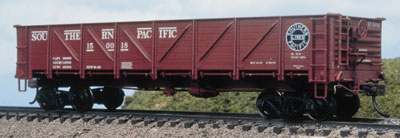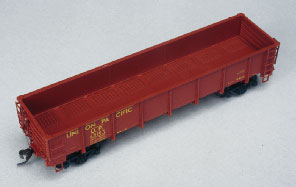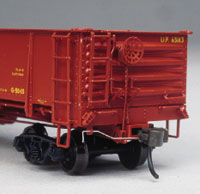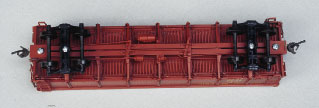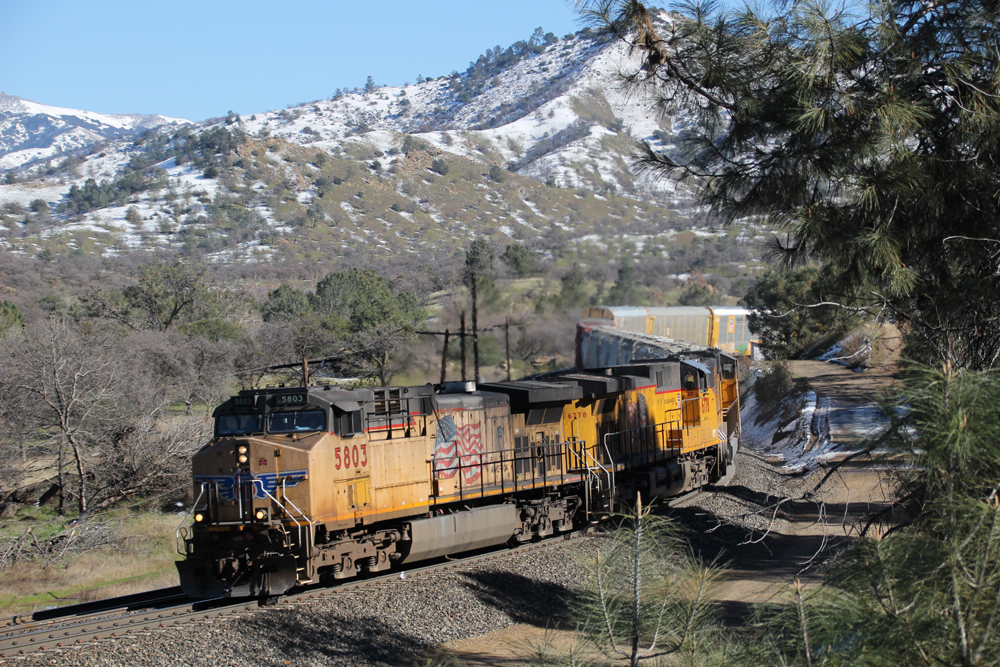To this point, difficult-to-assemble flat plastic kits or pricey and heavy brass imports were the only options available to modelers interested in these cars—neither made it easy to build entire trains of them. But this new injection-molded styrene kit makes building a large fleet of these distinctive cars easier than it’s ever been.
In many ways GS gons were the hoppers of the West in the time between the World Wars. Equipped with hatches in the floor, they could be used for bulk commodities like coal and gravel, but could still be utilized for cargo such as lumber or steel.
“General service” gondola is a descriptive term for a car type, much as “boxcar” or “hopper.” All GS gons were not alike as there were numerous, often marked, differences between the GS cars operated by various railroads. Cars varied in body style, door operating mechanism, construction, and end details. Our samples included a composite car painted and lettered for the Southern Pacific and a steel car painted for the Union Pacific.
Both cars matched their prototypes in appearance and lettering. The SP converted a number of cars to sugar beet service by adding wood side and end extensions to increase the capacity. Red Caboose also offers a sugar beet version of this kit (not shown here). A detailed article on the prototype cars, with numerous photographs, appeared in the March 2000 RailModel Journal.
Railroads operating significant fleets of GS gons included the Atchison, Topeka & Santa Fe; Denver & Rio Grande Western; Northern Pacific; Southern Pacific; Union Pacific; and Western Pacific. Midwestern railroads such as the Soo Line, Illinois Central, and Rock Island also had these cars. Prototype GS gons first appeared in the 1920s and many lasted in revenue service into the early 1960s.
The Red Caboose kit is typical of the current breed of highly detailed plastic freight cars. Be sure to read the instructions carefully before starting construction as there are some minor differences between the parts used on the steel and composite cars.
Among the tools and supplies I used to build the kits were a PBL flush- cutting nippers, liquid styrene cement, small screwdrivers, and a hobby knife. There are lots of small, delicate parts that need to be removed from the sprues and a model like this makes PBL’s nippers very handy.
Both cars went together without a hitch. The parts fit neatly in the holes and I found I didn’t need to open any holes up. If you find the parts don’t fit properly the holes may have filled with paint. Simply use a no. 75 drill bit in a pin vise to clear them.
The models include a thin flat weight that’s concealed between the upper and lower floors. The completed model weighs 1.8 ounces, considerably less than the National Model Railroad Association Recommended Practice of 3.75 ounces for a 40-foot car. Adding a load and substituting metal trucks and wheels for the kit’s plastic ones would increase the model’s weight.
The key brake components are included, but some modelers may want to add the piping between the control valve, reservoir, and cylinder. Lack of these details is the only problem I have with the appearance of the model. With so much of the underside exposed, such details would add greatly.
I was especially impressed with the door actuating rods. These are easy to install and contribute to the realistic appearance of the model.
Our models included plastic wheelsets and McHenry automatic magnetic knuckle couplers. All the wheelsets were in gauge and the coupler height matched a Kadee height gauge.
If you find each new boxcar release looks a little too much alike and you’re longing for something really different on your roster, pick up a string of Red Caboose GS gons. These stand-out cars are a much needed addition to the selection of HO freight cars and the ease of assembly and prototypical accuracy means they should be appearing in droves on Western railroads.
Price: $16.95 decorated; $13.95 undecorated
Manufacturer:
Red Caboose
P. O. Box 250
Mead, CO 80542
Description:
Injection-molded styrene kit
Road names:
Composite sides:
Southern Pacific (two schemes)
Union Pacific
Western Pacific
Undecorated
Composite sides, sugar beet cars:
undecorated (with plywood or board extensions)
SP
USGX
WP
Steel sides:
Boston & Maine
Canadian National
Canadian Pacific
Denver & Rio Grande Western
Great Northern
Illinois Central
Northern Pacific
SP
UP
WP
Undecorated





